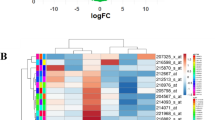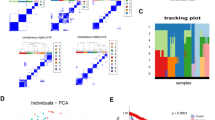Abstract
Background
Long noncoding RNAs (lncRNAs) can act as competitive endogenous RNAs (ceRNAs) to compete with mRNAs for binding miroRNAs (miRNAs). The dysregulated triplets, composed by mRNAs, lncRNAs, and miRNAs, contributed to the development and progression of diseases, such as cancer. However, the roles played by triplet biomarkers are not fully understand in glioblastoma multiforme (GBM) patient survival.
Objectives
Here, we constructed a differential triplet interaction network (TriNet) between GBM and normal tissues and identified GBM survival related triplets.
Methods
Four significantly dysregulated modules, enriched differentially expressed molecules, were identified by integrating affinity propagation method and hypergeometric method. Furthermore, knockdown of TP73-AS1 was implemented by siRNA and the expression of RFX1 was examined in U87 cells by qRT-PCR. The apoptosis of U87 cells was investigated using MTT assay and Acridine orange/Ethidium bromide (AO/EB) assay.
Results
We randomly split GBM samples into training and testing sets, and found that these four modules can robustly and significantly distinguish low- and high-survival patients in both two sets. By manually curated literatures for triplets mediated by core interactions, we found that members involved tumor invasion, proliferation, and migration. The dysregulated triplets may cause the poor survival of GBM patients. We finally experimentally verified that knockdown of TP73-AS1, an lncRNA of one triplet, could not only reduce the expression of RFX1, an mRNA of this triplet, but also induce apoptosis in U87 cells.
Conclusions
These results can provide further insights to understand the functions of triplet biomarkers that associated with GBM prognosis.





Similar content being viewed by others
References
Ahmadloo N, Kani AA, Mohammadianpanah M, Nasrolahi H, Omidvari S, Mosalaei A, Ansari M (2013) Treatment outcome and prognostic factors of adult glioblastoma multiforme. J Egypt Natl Canc Inst 25:21–30. doi:10.1016/j.jnci.2012.11.001
Alifieris C, Trafalis DT (2015) Glioblastoma multiforme: Pathogenesis and treatment. Pharmacol Ther 152:63–82. doi:10.1016/j.pharmthera.2015.05.005
Bastien JI, McNeill KA, Fine HA (2015) Molecular characterizations of glioblastoma, targeted therapy, and clinical results to date. Cancer 121:502–516. doi:10.1002/cncr.28968
Becker KG, Barnes KC, Bright TJ, Wang SA (2004) The genetic association database. Nat Genet 36:431–432. doi:10.1038/ng0504-431
Betel D, Wilson M, Gabow A, Marks DS, Sander C (2008) The microRNA.org resource: targets and expression. Nucleic Acids Res 36:D149–D153. doi:10.1093/nar/gkm995
Bodenhofer U, Kothmeier A, Hochreiter S (2011) APCluster: an R package for affinity propagation clustering. Bioinformatics 27:2463–2464. doi:10.1093/bioinformatics/btr406
Bosson AD, Zamudio JR, Sharp PA (2014) Endogenous miRNA and target concentrations determine susceptibility to potential ceRNA competition. Mol Cell 56:347–359. doi:10.1016/j.molcel.2014.09.018
Carlsson SK, Brothers SP, Wahlestedt C (2014) Emerging treatment strategies for glioblastoma multiforme. EMBO Mol Med 6:1359–1370. doi:10.15252/emmm.201302627
Chen G et al (2013) LncRNADisease: a database for long-non-coding RNA-associated diseases. Nucleic Acids Res 41:D983–D986. doi:10.1093/nar/gks1099
Chen F et al (2016) Up-regulation of microRNA-16 in Glioblastoma Inhibits the Function of Endothelial Cells and Tumor Angiogenesis by Targeting Bmi-1. Anticancer Agents Med Chem 16:609–620
Denzler R, Agarwal V, Stefano J, Bartel DP, Stoffel M (2014) Assessing the ceRNA hypothesis with quantitative measurements of miRNA and target abundance. Mol Cell 54:766–776. doi:10.1016/j.molcel.2014.03.045
Friedman RC, Farh KK, Burge CB, Bartel DP (2009) Most mammalian mRNAs are conserved targets of microRNAs. Genome Res 19:92–105. doi:10.1101/gr.082701.108
Giza DE, Vasilescu C, Calin GA (2014) MicroRNAs and ceRNAs: therapeutic implications of RNA networks. Expert Opin Biol Ther 14:1285–1293. doi:10.1517/14712598.2014.920812
Hafner M et al (2010) Transcriptome-wide identification of RNA-binding protein and microRNA target sites by PAR-CLIP. Cell 141:129–141. doi:10.1016/j.cell.2010.03.009
Harrow J et al (2006) GENCODE: producing a reference annotation for ENCODE Genome Biol 7 Suppl 1:S4 1–9 doi:10.1186/gb-2006-7-s1-s4
Hsu YC, Liao WC, Kao CY, Chiu IM (2010) Regulation of FGF1 gene promoter through transcription factor RFX1. J Biol Chem 285:13885–13895. doi:10.1074/jbc.M109.081463
Hsu SD et al (2011) miRTarBase: a database curates experimentally validated microRNA-target interactions. Nucleic Acids Res 39:D163–D169. doi:10.1093/nar/gkq1107
Jayaram S, Gupta MK, Polisetty RV, Cho WC, Sirdeshmukh R (2014) Towards developing biomarkers for glioblastoma multiforme: a proteomics view. Expert Rev Proteomics 11:621–639. doi:10.1586/14789450.2014.939634
Jiang Q et al (2009) miR2Disease: a manually curated database for microRNA deregulation in human disease. Nucleic Acids Res 37:D98–D104. doi:10.1093/nar/gkn714
Jun S et al. (2013) PAF-mediated MAPK signaling hyperactivation via LAMTOR3 induces pancreatic tumorigenesis. Cell Rep 5:314–322 doi:10.1016/j.celrep.2013.09.026
Kertesz M, Iovino N, Unnerstall U, Gaul U, Segal E (2007) The role of site accessibility in microRNA target recognition. Nat Genet 39:1278–1284. doi:10.1038/ng2135
Kim J, Abdelmohsen K, Yang X, De S, Grammatikakis I, Noh JH, Gorospe M (2016) LncRNA OIP5-AS1/cyrano sponges RNA-binding protein HuR. Nucleic Acids Res 44:2378–2392. doi:10.1093/nar/gkw017
Kozomara A, Griffiths-Jones S (2014) miRBase: annotating high confidence microRNAs using deep sequencing data. Nucleic Acids Res 42:D68–D73. doi:10.1093/nar/gkt1181
Lee GL, Dobi A, Srivastava S (2011) Prostate cancer: diagnostic performance of the PCA3 urine test. Nat Rev Urol 8:123–124. doi:10.1038/nrurol.2011.10
Li SQ et al (2014a) Comparison of long noncoding RNAs, microRNAs and messenger RNAs involved in initiation and progression of esophageal squamous cell carcinoma. Mol Med Rep 10:652–662 doi:10.3892/mmr.2014.2287
Li Y, Qiu C, Tu J, Geng B, Yang J, Jiang T, Cui Q (2014b) HMDD v2.0: a database for experimentally supported human microRNA and disease associations. Nucleic Acids Res 42:D1070–D1074. doi:10.1093/nar/gkt1023
Liu XH et al (2014) Lnc RNA HOTAIR functions as a competing endogenous RNA to regulate HER2 expression by sponging miR-331-3p in gastric cancer. Mol Cancer 13:92. doi:10.1186/1476-4598-13-92
Mao XG et al (2013) LIN28A facilitates the transformation of human neural stem cells and promotes glioblastoma tumorigenesis through a pro-invasive genetic program. Oncotarget 4:1050–1064. doi:10.18632/oncotarget.1131
Meisner NC, Filipowicz W (2011) Properties of the Regulatory RNA-Binding Protein HuR and its Role in Controlling miRNA Repression. Adv Exp Med Biol 700:106–123. doi:10.1007/978-1-4419-7823-3_10
Muller S et al (2015) Next-generation sequencing reveals novel differentially regulated mRNAs, lncRNAs, miRNAs, sdRNAs and a piRNA in pancreatic cancer. Mol Cancer 14:94. doi:10.1186/s12943-015-0358-5
Nicolaidis S (2015) Biomarkers of glioblastoma multiforme. Metabolism 64:S22–S27. doi:10.1016/j.metabol.2014.10.031
Ohashi Y, Ueda M, Kawase T, Kawakami Y, Toda M (2004) Identification of an epigenetically silenced gene, RFX1, in human glioma cells using restriction landmark genomic scanning. Oncogene 23:7772–7779. doi:10.1038/sj.onc.1208058
Ohka F, Natsume A, Wakabayashi T (2012) Current trends in targeted therapies for glioblastoma multiforme. Neurol Res Int 2012:878425 doi:10.1155/2012/878425
Paraskevopoulou MD, Georgakilas G, Kostoulas N, Reczko M, Maragkakis M, Dalamagas TM, Hatzigeorgiou AG (2013) DIANA-LncBase: experimentally verified and computationally predicted microRNA targets on long non-coding RNAs. Nucleic Acids Res 41:D239–D245. doi:10.1093/nar/gks1246
Peng W et al (2015) Long non-coding RNA MEG3 functions as a competing endogenous RNA to regulate gastric cancer progression. J Exp Clin Cancer Res 34:79. doi:10.1186/s13046-015-0197-7
Pilyugin M, Irminger-Finger I (2014) Long non-coding RNA and microRNAs might act in regulating the expression of BARD1 mRNAs. Int J Biochem Cell Biol 54:356–367. doi:10.1016/j.biocel.2014.06.018
Polivka J Jr, Polivka J, Rohan V, Topolcan O, Ferda J (2012) New molecularly targeted therapies for glioblastoma multiforme. Anticancer Res 32:2935–2946
Rehmsmeier M, Steffen P, Hochsmann M, Giegerich R (2004) Fast and effective prediction of microRNA/target duplexes. RNA 10:1507–1517. doi:10.1261/rna.5248604
Salmena L, Poliseno L, Tay Y, Kats L, Pandolfi PP (2011) A ceRNA hypothesis: the Rosetta Stone of a hidden RNA language? Cell 146:353–358. doi:10.1016/j.cell.2011.07.014
Schwamb B et al (2015) FAM96A is a novel pro-apoptotic tumor suppressor in gastrointestinal stromal tumors. Int J Cancer 137:1318–1329. doi:10.1002/ijc.29498
Shi Y et al (2014) Long non-coding RNA H19 promotes glioma cell invasion by deriving miR-675. PLoS One 9:e86295. doi:10.1371/journal.pone.0086295
Srikantan S, Tominaga K, Gorospe M (2012) Functional interplay between RNA-binding protein HuR and microRNAs. Curr Protein Pept Sci 13:372–379
Steigedal TS, Prestvik WS, Selvik LK, Fjeldbo CS, Bruland T, Laegreid A, Thommesen L (2013) Gastrin-induced proliferation involves MEK partner 1 (MP1). In Vitro Cell Dev Biol Anim 49:162–169. doi:10.1007/s11626-013-9588-2
Su X, Xing J, Wang Z, Chen L, Cui M, Jiang B (2013) microRNAs and ceRNAs: RNA networks in pathogenesis of cancer. Chin J Cancer Res 25:235–239. doi:10.3978/j.issn.1000-9604.2013.03.08
Tay Y, Karreth FA, Pandolfi PP (2014) Aberrant ceRNA activity drives lung cancer. Cell Res 24:259–260. doi:10.1038/cr.2014.21
Thum T, Condorelli G (2015) Long noncoding RNAs and microRNAs in cardiovascular pathophysiology. Circ Res 116:751–762. doi:10.1161/CIRCRESAHA.116.303549
Tian LQ, Liu EQ, Zhu XD, Wang XG, Li J, Xu GM (2016) MicroRNA-197 inhibits cell proliferation by targeting GAB2 in glioblastoma. Mol Med Rep 13:4279–4288 doi:10.3892/mmr.2016.5076
Tripathi V et al (2013) Long noncoding RNA MALAT1 controls cell cycle progression by regulating the expression of oncogenic transcription factor B-MYB. PLoS Genet 9:e1003368. doi:10.1371/journal.pgen.1003368
Urbanska K, Sokolowska J, Szmidt M, Sysa P (2014) Glioblastoma multiforme—an overview. Contemp Oncol (Pozn) 18:307–312 doi:10.5114/wo.2014.40559
Vergoulis T et al (2012) TarBase 6.0: capturing the exponential growth of miRNA targets with experimental support. Nucleic Acids Res 40:D222–D229. doi:10.1093/nar/gkr1161
Wang P, Ren Z, Sun P (2012) Overexpression of the long non-coding RNA MEG3 impairs in vitro glioma cell proliferation. J Cell Biochem 113:1868–1874. doi:10.1002/jcb.24055
Wang X et al (2014) Targeted delivery of tumor suppressor microRNA-1 by transferrin-conjugated lipopolyplex nanoparticles to patient-derived glioblastoma stem cells. Curr Pharm Biotechnol 15:839–846
Wang X et al (2015) Silencing of long noncoding RNA MALAT1 by miR-101 and miR-217 inhibits proliferation, migration, and invasion of esophageal squamous cell carcinoma cells. J Biol Chem 290:3925–3935. doi:10.1074/jbc.M114.596866
Westerman BA et al (2011) A genome-wide RNAi screen in mouse embryonic stem cells identifies Mp1 as a key mediator of differentiation. J Exp Med 208:2675–2689. doi:10.1084/jem.20102037
Wilson TA, Karajannis MA, Harter DH (2014) Glioblastoma multiforme: State of the art and future therapeutics. Surg Neurol Int 5:64. doi:10.4103/2152-7806.132138
Yang JH, Li JH, Shao P, Zhou H, Chen YQ, Qu LH (2011) starBase: a database for exploring microRNA-mRNA interaction maps from Argonaute CLIP-Seq and Degradome-Seq data. Nucleic Acids Res 39:D202–D209. doi:10.1093/nar/gkq1056
Yang J et al (2014a) FOXO1 3′UTR functions as a ceRNA in repressing the metastases of breast cancer cells via regulating miRNA activity. FEBS Lett 588:3218–3224. doi:10.1016/j.febslet.2014.07.003
Yang TQ et al (2014b) MicroRNA-16 inhibits glioma cell growth and invasion through suppression of BCL2 and the nuclear factor-kappaB1/MMP9 signaling pathway. Cancer Sci 105:265–271. doi:10.1111/cas.12351
Yoon JH, Abdelmohsen K, Gorospe M (2014) Functional interactions among microRNAs and long noncoding RNAs. Semin Cell Dev Biol 34:9–14. doi:10.1016/j.semcdb.2014.05.015
Zang W et al (2016) Knockdown of long non-coding RNA TP73-AS1 inhibits cell proliferation and induces apoptosis in esophageal squamous cell carcinoma. Oncotarget. doi:10.18632/oncotarget.6963
Zhang J, Fan D, Jian Z, Chen GG, Lai PB (2015) Cancer Specific Long Noncoding RNAs Show Differential Expression Patterns and Competing Endogenous RNA Potential in Hepatocellular Carcinoma. PLoS One 10:e0141042. doi:10.1371/journal.pone.0141042
Acknowledgements
This work was supported by the nature fund of International S&T Cooperation Program of China (No. 2014DFA31630), National Nature Science Foundation of China (No. 81571646), Specialized Research Fund for the Doctoral Program of Higher Education (No. 20132307110029), Application technology research and development project of Heilongjiang Province (No. GA15C108), Application technology research and development project of Heilongjiang Province (No. GA15C103-01), NaturalScience Foundation of China (81302176 X.C.), National Nature Science Foundation of China (No. 81500924), Natural Science Foundation of Heilongjiang Province (No. 2015062), Natural Science Foundation of Heilongjiang Province (No. H201348), Scientific and Technology Research Fund of Heilongjiang Education Department (No. 12541469), Natural Science Foundation of Heilongjiang Province (No. H201434).
Author information
Authors and Affiliations
Corresponding author
Ethics declarations
Conflict of interest
The authors declare that there is no conflict of interests regarding the publication of this paper.
Electronic supplementary material
Below is the link to the electronic supplementary material.
Rights and permissions
About this article
Cite this article
Wang, JB., Liu, FH., Chen, JH. et al. Identifying survival-associated modules from the dysregulated triplet network in glioblastoma multiforme. J Cancer Res Clin Oncol 143, 661–671 (2017). https://doi.org/10.1007/s00432-016-2332-z
Received:
Accepted:
Published:
Issue Date:
DOI: https://doi.org/10.1007/s00432-016-2332-z




